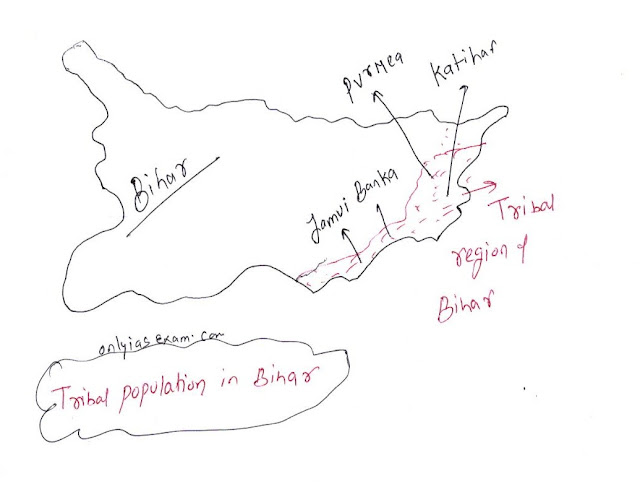Tribal Population of Bihar:
After the bifurcation of Bihar into two states-Bihar and Jharkhand in 2000, most of the tribal population area moved to Jharkhand.
As of the 2001 India census, Bihar had a tribal population of about 7.6 lakh.
According to the 2011 census, Bihar had a tribal population of about 13.4 lakh.
Now at present, Bihar has about 20 lakh tribal population, which is about 1% of the total population of the state.
There are 14 districts of Bihar where a dense population of tribes is found. The districts of Katihar (6% tribal population), Jamui, Banka, and Purnia have the largest tribal population in Bihar.
The major tribes of Bihar are Santhals, Oraons, Gonds, and Kharwars. Santhal is the largest tribe in Bihar.
The following are the problems of the tribal population in Bihar;
Socio-economic problems;
As we know that the livelihood of the tribes lies in the forest. But there is not much forest in Bihar, whatever it is, it is also decreasing day by day. Therefore, most of the tribal population is engaged in agricultural activities. Most of the people worked as agricultural laborers in other areas as most of the tribes did not have enough land for agriculture.
Some tribes do not even have land to build houses.
Some tribes have small size of land.
Tribes in Bihar do not have the right to sell land to non-tribals and they are not even aware of the prices of their land. For this reason, some rich tribal people buy the land of poor tribal people cheaply.
Poverty is prevalent in tribal communities.
According to the 2011 census, the literacy rate of tribals in Bihar is 55.68%. The sex ratio is around 952 (females per 1000 males).
Due to poor literacy rates and poor skills among the tribes, they are not able to work in the manufacturing and service sectors as these sectors require a skilled labor force.
In the tribal population areas, there is a severe lack of facilities like basic necessities like schools, hospitals, roads, and electricity. Due to this lack of basic facilities, low literacy among the tribes, and poverty, people often get involved in Naxalism.
There is a problem of malnutrition among children and women, due to which there is a high mortality rate among children in these areas.
Tuberculosis, leprosy, iodine deficiency, liver dysfunction due to alcohol, etc. are common diseases present in the tribal communities of Bihar.
Lacks Political will;
Since 2001, the government has not conducted an accurate population census of tribal communities in Bihar. The tribal population is seen as 'doubtful citizens' as they do not have written documents of land ownership rights.
There is neither a Tribal Commission nor a single building of TRIFED (Tribal Cooperative Marketing Development Federation) in the state.
Overall, not much attention is being paid to their development politically.
Steps were taken by the states of Bihar to solve the problems of the tribes;
After the bifurcation of Bihar, the state has not paid much attention to the development of tribal communities.
Following are some of the schemes related to tribal communities;
In order to promote forest products and to increase the income of the tribal people, the state government under the leadership of the Minister of Tribal Development has started Van Dhan Yojana.
The Chief Minister has started Chhatra Vriti Yojana to increase the participation of scheduled caste and scheduled tribe students in public service. Rs 50,000 for clearing BPSC prelims and Rs 1 lakh for clearing UPSC prelims will be given to SC and ST students.
Under the Mukhyamantri Scheduled Caste and Scheduled Caste Chhatra Yojana, the government will provide 1000 rupees to all the scheduled caste and scheduled tribe students residing in the hostels of recognized institutions.
Try to solve the following questions:
- Mention the problems of the tribal population in Bihar and discuss the steps being taken by the State to solve them. ( 65th BPSC geography)
You may like also:

ConversionConversion EmoticonEmoticon